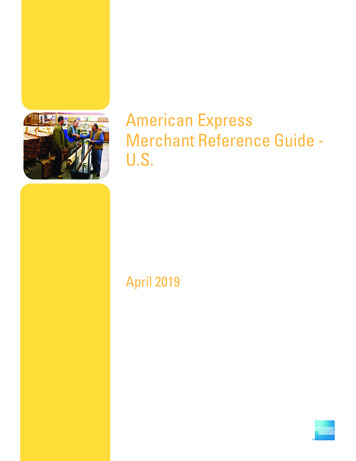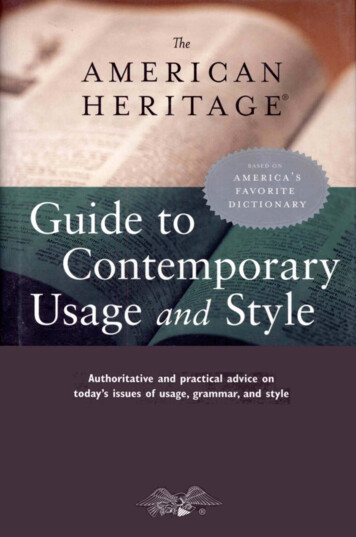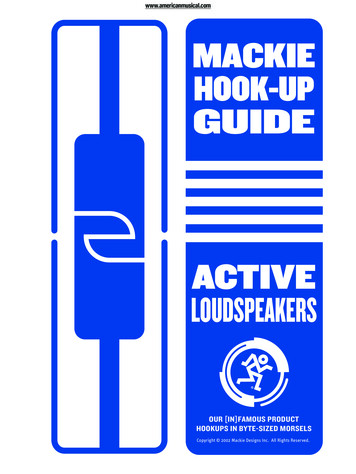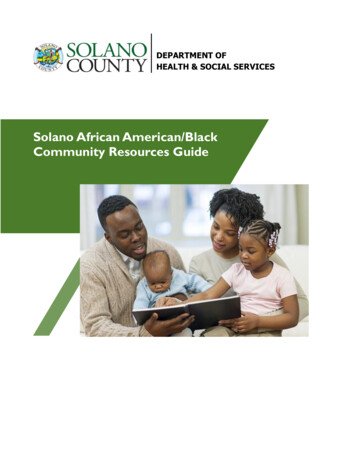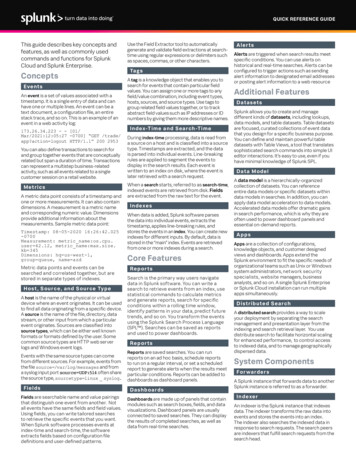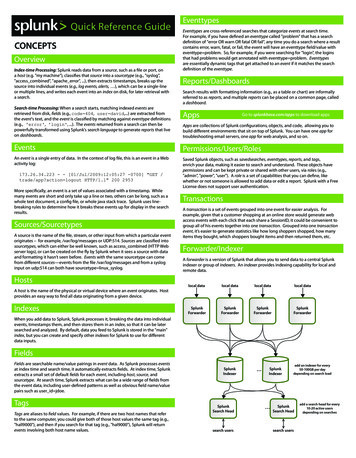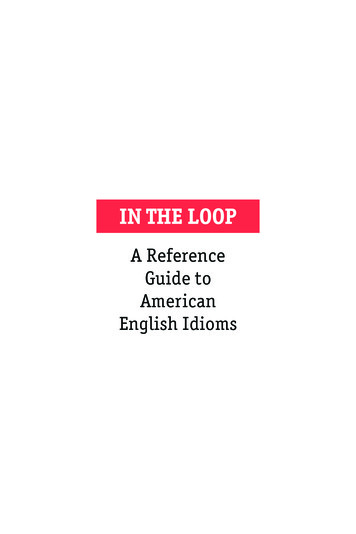
Transcription
IN THE LOOPA ReferenceGuide toAmericanEnglish Idioms
In the Loop:A Reference Guide to American English IdiomsPublished by the Office of English Language ProgramsUnited States Department of StateWashington, DC 20037First Edition 2010Adapted from:Something to Crow About by Shelley Vance Laflin;ed. Anna Maria Malkoç, Frank SmolinskiIllustrated American Idioms by Dean CurrySpecial thanks to Elizabeth Ball for copyeditingand proofreading this 2010 edition.Office of English Language ProgramsBureau of Cultural and Educational AffairsUnited States Department of StateWashington, DC 20037englishprograms.state.gov
Contentsvvi1103107121IntroductionHow Each Entry is ArrangedPart 1: Idioms and DefinitionsPart 2: Selected Idioms by CategoryPart 3: Classroom ActivitiesIndex
IntroductionIdiom: a group of words that means somethingdifferent than the individual words it containsIn the Loop is a collection of common idiomsupdated and compiled from two previous books ofidioms published by the Office of English LanguagePrograms: Illustrated American Idioms by DeanCurry and Something to Crow About by Shelley VanceLaflin. In the Loop combines the popular aspects ofthe previous books, while also updating the contentby including idioms that have come into use morerecently and eliminating those that are rarely used.When available, background information is includedabout the origins of the idioms. Additionally, In theLoop includes categories of commonly used idiomsand suggestions to the teacher to aid in developingclassroom exercises for learning the meanings anduses of idioms. In essence, this book is intended tobe both a teaching tool and a reference.As with any language, American English is fullof idioms, especially when spoken. Idiomsadd color and texture to language by creatingimages that convey meanings beyond those ofthe individual words that make them up. Idiomsare culturally bound, providing insight into thehistory, culture, and outlook of their users. Thisis because most idioms have developed overtime from practices, beliefs, and other aspectsof different cultures. As a culture changes, thewords used to describe it also change: someidioms fall out of use and others develop toreplace them. With idioms in particular, the beliefsor practices leading to their use may disappear whilethe idiom itself continues to be used. Idioms can beso overused that they become clichés; or they canbecome slang or jargon, expressions used mainly byspecific groups or professions.Organization of this Book. In the Loop is dividedinto three parts: Part 1, “Idioms and Definitions”;Part 2, “Selected Idioms by Category”; and Part3, “Classroom Activities.” The idioms are listedalphabetically in Part 1. Part 2 highlights someof the most commonly used idioms, grouped intocategories. Part 3 contains classroom suggestionsto help teachers plan appropriate exercises fortheir students. There is also a complete index atthe back of the book listing page numbers for bothmain entries and cross-references for each idiom.Idioms can be complimentary or insulting. They canexpress a wide range of emotions from excitementto depression, love to hate, heroism to cowardice,and anything in between. Idioms are also used toexpress a sense of time, place, or size. The range ofuses for idioms is complex and widespread.The complexity of idioms is what makes themso difficult for non-native speakers to learn.However, this complexity is also what can makeidioms so interesting to study and learn; theyare rarely boring. Learning about idioms, in thiscase those used in the United States, provides away to learn not only the language, but a littleabout the people who use it.How to Locate an Idiom. In Part 1, “Idioms andDefinitions,” idioms are listed alphabetically byfirst word. The only first words not used to placethe idioms in order are articles (a, the, some) andpronouns and possessives (someone, one). Instead,these are placed at the end of the idiom, separatedby a comma.v
How Each Entry is Arrangedidiom’s main entrydefinition of the idiom1 FEATHER IN (ONE’S) CAP, Aan exceptional achievementsample sentencesusing the idiom321. Cassandra managed through hard work to wina big contract for her company. It was a realfeather in her cap.2. The scholarship Lee won toattend the university was a feather in his cap.Synonym: something to crow aboutAntonym: nothing to write home aboutadditional informationabout the idiom4Compare to: feather (one’s) nest5cross-referencedidioms for comparisonThe practice of placing a feather in one’s cap is centuriesold and appears to have been practiced in many differentcultures. The feather was awarded and worn as a sign ofa signif icant achievement by the wearer. In somecultures, such as in 16th century Hungary, it was even acrime to wear a feather when one had not earned theright to wear it.The idiom (1) is given first, followed by itsdefinition (2). Then, two or three examplesentences (3) are provided to illustrate howthe idiom is used. Occasionally, an idiom hasmore than one meaning. Where this occurs,each meaning for the idiom is numbered withcorresponding numbers in the sample sentences.All entries include the idiom (1), definition (2),and sample sentences (3).information (5), includes notes such as theorigins of the expression, restrictions on usage,or any additional information that might help alearner understand when and how a particularidiom is used.Symbols Used in the Entries. Some idioms mayhave one or two alternate words that are usedinterchangeably without altering the meaning.One example of this is in a fix/bind/jam. In thisidiom, fix, bind, or jam can be used withoutchanging the idiom’s meaning. In such cases thepossible alternates are separated by a slash (/).The f inal two elements—cross-referencedidioms (4) and additional information (5)—are included only where relevant or available.There are three types of cross-references used:synonym, antonym, and compare to. Synonymsare expressions that have the same meaning asthe idiom. Antonyms are expressions that meanthe opposite of the idiom. Compare to includesexpressions that might be mistaken as similarto, or related to, the idiom. In the illustratedentr y above, for example, feather (one’s)nest has a completely different meaning thanfeather in (one’s) cap, even though they bothrefer to a feather. The final section, additionalSome idioms require context-specific subjectsor objects. In these cases someone, something,or one are placed in parenthesis within theidiom. (Someone) or (something) is used whenthe idiom’s object is different than the subject.For example, in beat (someone) to the punch,someone is a different person than the subjectas in I beat him to the punch. The pronoun oneis used when the subject and object of the idiomis the same person, as in ace up (one’s) sleeve(He had an ace up his sleeve).vi
Part 1Idioms and DefinitionsAACID TESTthe most crucial or important test of worth1. Parents might be willing to buy this new toy for theirchildren but the real acid test is whether or not thechildren themselves like it.ACE IN THE HOLEa hidden but effective means of winning aconflict2. The acid test for laundry soap is not how well it cleansin hot water, but how well it cleans in cold water.1. The other team thinks they can win this basketballgame, but that’s only because we haven’t put ourbest player in yet. He’s our ace in the hole.The expression originates from the use of nitric acid on goldto determine whether the gold was genuine.2. It looked like the politician would lose the debateuntil he brought up his ace in the hole, an argumentthat nobody could refute.ACROSS THE BOARDequally for everyone, for everything, or in allcasesThe expression originates from some forms of the card gamepoker, in which players have both community cards andprivate (“hole”) cards in their hands. To have an ace in one’sprivate hand means that one can win the game without otherssuspecting ahead of time.1. The boss made some people angry. He gave 5% payraises across the board but some people thought theyshould have gotten more than others.2. The car dealership was cutting prices across theboard. Every car was on sale, not just a few.ACE UP (ONE’S) SLEEVEto have an effective but hidden means toaccomplish somethingACTIONS SPEAK LOUDER THAN WORDSthe things that people do (actions) are moreimportant than the things they say (words)1. It looks like Joanne is going to lose, but I wouldn’tbe too sure. She may have an ace up her sleeve.1. She’s promised to be nicer to her sister from now on,but actions speak louder than words.2. No matter how many times I think Paul might lose tome in a game of chess, he never does. He always hasan ace up his sleeve and wins every game.2. Every politician will claim that he or she cares aboutthe problems of the average person, but actionsspeak louder than words.The expression originates from card games like poker, in whichplayers might hide an extra ace up their sleeves to use in casethey were losing the game and wanted to cheat.This expression implies that we can learn about a person’strue intentions by looking at what they do rather than whatthey say.ACHILLES’ HEELa person’s weakness or the vulnerable spot in hisor her characterALBATROSS AROUND (ONE’S) NECKsomething or someone that is a burden anddifficult to get rid of1. We’ve got to find his Achilles’ heel if we hope todefeat him.1. That car costs you so much to repair. It has becomean albatross around your neck. Why don’t you get ridof it?2. John appears to be a highly respected citizen, but I’msure he has his Achilles’ heel.2. I hired my wife’s brother to work in my business buthe’s worthless. He doesn’t do anything. He really isan albatross around my neck.Achilles was a figure in Greek mythology who was invulnerablein battle except for his heel. It was the one weak spot on hisbody.Synonym: millstone around (one’s) neck1
ARMED TO THE TEETHwell-equipped with weaponsAn albatross is a large sea bird. The expression comes fromthe poem “The Rime of the Ancient Mariner” by Samuel T.Coleridge, in which a sailor shoots a helpful albatross with acrossbow, bringing bad luck on the crew of the ship. The othersailors hang the bird around the sailor’s neck as punishment.1. The police won’t enter the bank where the thief is.He’s armed to the teeth.2. The invading soldiers were armed to the teeth. Therewas no way the defenders could hope to win.ALL KIDDING ASIDEspeaking seriouslyThe expression suggests having weapons (arms) from one’stoes to one’s teeth.1. That was a good joke, but all kidding aside, we haveto get to work now.AS THE CROW FLIESdirectly or in a straight line, without roads2. What you’re telling me sounds unbelievable. Allkidding aside, are you serious?1. The town is 25 miles from here as the crow flies, butit’s over 40 miles by car.ALL THUMBSuncoordinated and awkward, especially withone’s hands2. As the crow flies, the airport isn’t very far, but youcan’t get there directly. You have to drive around themountains.1. I’ve tried to put this toy together according to theinstructions, but I’m all thumbs. I can’t seem to getthe parts to fit.The expression is used to describe the distance between twopoints as an airplane or bird might fly, without taking intoaccount the twists and turns in the road.2. Peter seems to be all thumbs today. He keepsdropping his tools.AT LOGGERHEADSin strong disagreement, in a quarrel; at animpasseALL WETwrong to the point of being silly or unbelievable1. They have been arguing all day about what to do.They really are at loggerheads.1. He’s all wet if he thinks I’m going to believe his lies.2. Don’t listen to Maria. She doesn’t know what she’stalking about. She’s all wet.2. John and Richard are at loggerheads about whatwould be a fair price for the car. John thinksRichard’s price is far too low.Compare to: not know beans about (something); out to lunch;for the birds; talk through (one’s) hatAT (ONE’S) WITS’ ENDat a loss about what to do next; in a state offrustrationALONG FOR THE RIDE, GO/COMEto be present for an activity without taking partin it1. When the woman looked around and couldn’t findher little daughter, she looked up and down everyaisle in the store until she was at her wits’ end. Shewas almost hysterical when another customer in thestore suggested that she notify the store’s securityofficer.1. Janet’s brothers went up into the mountains to dosome fishing. Janet doesn’t fish, but she went alongfor the ride.2. I don’t need to do any shopping, but perhaps I’llcome along for the ride if that’s okay with you.2. We can’t seem to persuade our son to stay in school.We have tried every argument we can think of, butnothing seems to help. We don’t know what to do,and we’re at our wits’ end.The expression suggests that the ride itself is the extent of theperson’s participation in the activity, and that the person doesnot take part in the activity that is the purpose of the ride.APPLE OF (ONE’S) EYEa person or thing that is precious or loved aboveall elseSynonyms: at the end of (one’s) ropeCompare to: keep (one’s) wits about (oneself); use (one’s) wits;scared out of (one’s) wits1. Richard is so attached to his daughter that he woulddo anything for her. She’s the apple of his eye.The word wits means mental abilities.2. The boy won’t behave in school, but you can’tconvince his parents. He’s the apple of their eye.AT THE DROP OF A HATon any pretext; without needing an excuse orreasonCenturies old, this expression stems from the ancient beliefthat the pupil of the eye was solid and shaped like an apple.The pupil was considered precious since one could not seewithout it.1. Those workmen look for any reason to stop working.They’ll put down their tools at the drop of a hat.2. Nancy really doesn’t want to stay in her present job.She’ll leave for another one at the drop of a hat.2
AT THE END OF (ONE’S) ROPEno longer able to deal with a bad situation1. I just don’t know what to do with my son. He hasmisbehaved all d
American English Idioms. In the Loop: A Reference Guide to American English Idioms Published by the Office of English Language Programs United States Department of State Washington, DC 20037 First Edition 2010 Adapted from: Something to Crow About by Shelley Vance Laflin; ed. Anna Maria Malkoç, Frank Smolinski Illustrated American Idioms by Dean Curry Special thanks to Elizabeth Ball for .File Size: 2MBPage Count: 134Explore further377 common IDIOMS and their meanings - PORTALLASportallas.comAmerican Idioms: 80 Popular American Idioms You Need to .7esl.comCommonly used Idioms - Smart Wordswww.smart-words.orgEnglish Idioms You Should Know (FREE PDF)www.learnenglishteam.comAMERICAN SLANG WORDS AND PHRASESwww.umass.eduRecommended to you based on what's popular Feedback
